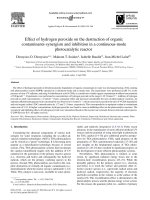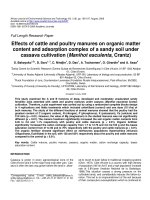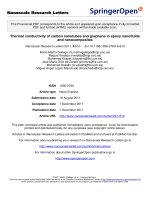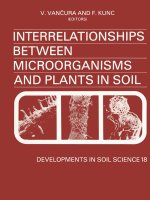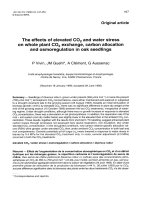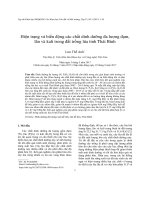Soil organic carbon, phosphorus and potassium in soils under poplar based agro-forestry in Punjab
Bạn đang xem bản rút gọn của tài liệu. Xem và tải ngay bản đầy đủ của tài liệu tại đây (351.83 KB, 8 trang )
Int.J.Curr.Microbiol.App.Sci (2020) 9(7): 1117-1124
International Journal of Current Microbiology and Applied Sciences
ISSN: 2319-7706 Volume 9 Number 7 (2020)
Journal homepage:
Original Research Article
/>
Soil Organic Carbon, Phosphorus and Potassium in Soils under Poplar
Based Agro-Forestry in Punjab
Navjot Kaur Dhillon1*, Pritpal Singh2 and Harinder Singh3
1
Directorate of Extension Education, Punjab Agricultural University, Ludhiana, India
2
Krishi Vigyan Kendra, Mansa, PAU, Punjab, India
3
Farm Advisory Service Centre, Faridkot, PAU, Punjab, India
*Corresponding author
ABSTRACT
Keywords
Bulk density, Poplar
based agro-forestry,
C sequestration,
SOC stock,
available-P,
Available-K
Article Info
Accepted:
11 June 2020
Available Online:
10 July 2020
Soil samples (0-60 cm) were collected from poplar based agro-forestry
system varying in age from 2-20 years to study changes in total soil organic
C (SOC), available phosphorus (P) and potassium (K). Soil plough layer (015 cm) had significantly higher SOC concentration by 34, 61 and 83%,
compared with 15-30, 30-45 and 45-60 cm soil depths, respectively. Soil
organic C decreased significantly with increasing soil depth, regardless of
the age of poplar plantation period. The concentration of available-P and K
was significantly higher in the surface soil, and decreased with increasing
soil depth. Available-P increased significantly (p<0.05) by 16.3-17.7% and
available-K by 36.5-52.4% in soil plough layer (0-15 cm) under agroforestry for 20-yrs, compared with soils under agro-forestry for 2-yrs. Soils
under 20-yrs old agro-forestry system had 39.8% and 50.6% higher SOC
in 0-7.5 cm and 7.5-15 cm soil depth, compared with soils under 2-yrs old
plantation. These results revealed C and nutrients (P and K) sequestration
potential of poplar based agro-forestry system.
Introduction
Soil is an important sinks of C as soil organic
carbon (SOC), and plays a major role in its
cycling in terrestrial ecosystems. As an
important component of the C system, SOC
acts as a key indicator for assessing soil
quality and plays an important role in
increasing crop productivity (Gregorich et al.,
1994). On a global scale, soils contains 1500
Pg (1 Pg= 1015 g) of organic C in the first
meter of soil profile. The SOC pool comprise
60% of this total, ~170 Pg of which are stored
in 1.7 billion hectares of agricultural
croplands worldwide (Paustian et al., 2000;
Lal, 2008). Upper 30 cm soil layer stores
1117
Int.J.Curr.Microbiol.App.Sci (2020) 9(7): 1117-1124
almost half of SOC that represents upto 3times of the C stored in vegetation (Powlson
et al., 2011), and therefore is considered most
vulnerable to be lost as carbon dioxide (CO2).
Because of the historic losses of organic C
from croplands, most of cultivated soils are
exhausted of SOC and are far away from
saturation (Vaccari et al., 2011). Depletion of
the SOC pool in cultivated lands has been
attributed to lower C input, and higher C
outputs through oxidation, leaching of
dissolved organic C, and soil erosion (Lal
2004, Ghosh et al., 2012). Land-use change in
different agro-ecosystems largely determined
the potential for SOC storage and ultimately
C sequestration in soil (Bronick and Lal,
2005) due to remarkable alterations in organic
C inputs and dynamics. Agro-forestry is
believed to increase the soil organic matter
(SOM) through the addition of above and
below-ground biomass to soil.
Poplar (Populus deltoids) plantation under
agro-forestry annually add 2.9-3.3 Mg
biomass ha-1 and could supply 2.3 t C ha-1 yr-1
as roots and leaves (Chauhan et al., 2011;
Singh and Sharma, 2007). Agro-forestry
affects nutrient status of soils via addition of
leaf litter and also by plant uptake, and is
considered an important option for C
sequestration (Albrecht and Kandji, 2003).
Nutrient availability in soils is influenced by
the addition of organics (Gill and Meelu,
1983; Toor and Bahl, 1997; Sui and
Thompson, 2000; Singh et al., 2010).
After decomposition, poplar leaf and root
biomass adds organic matter to the soil and
may alter nutrient availability in soils. The
information on the effect of cumulative
addition of leaf and root biomass of poplar on
SOC and available nutrients is known to
lesser extent. Therefore, a study was
conducted to investigate the effect of age of
poplar based agro-forestry on profile
distribution of TOC in sub-tropical soils.
Materials and Methods
Soil samples (0-60 cm depth) were collected
from different sites under 2-20 years poplar
based agro-forestry in sub-tropical area of
Ropar district (Punjab, India) during ( ) . Soil
bulk density (Db) at surface and sub-surface
soil layers was determined by core method
using metallic cores. Soil cores collected from
each sampling were oven dried at 105oC for
24 h, and dry soil weight was recorded (Blake
and Hartge 1986). The Db (Mg m-3) was
calculated as: Db=Ws/Vt, Where, ‘Ws’ is
weight of soil (Mg) and Vt is the volume of
soil sample (m3). Soil samples were analyzed
for soil pH (1:2 soil: water suspension) with a
glass electrode (Elico, India), electrical
conductivity (E.C.,
1:2
soil:
water
supernatant) using a conductivity meter
(Elico, India). Available P in soil samples was
determined by extracting with 0.5M sodium
bicarbonate (pH 8.5; 1:20 soil: extractant)
(Olsen et al., 1954) and measuring P
concentration in the extract colorimeterically
(Murphy and Rilay, 1962). Available K in soil
samples was extracted with 1N ammonium
acetate (pH 7.0) (Mervin and Peech, 1950)
followed by flame photometric determination.
Total organic carbon (TOC) in soil was
determined by using 1N K2Cr2O7 solution
followed by heating at 150 oC for 1 hour
(Snyder and Trofymow, 1984). Total organic
C stock (as Mg C ha−1) in the 0-15 cm soil
plough layer was computed by multiplying
the respective TOC concentration (%) with
measured soil bulk density (Mg m−3) and
depth (m) of sampling using the following
formula:
Statistical analysis
Statistical analysis of soil samples collected
under different agro-forestry systems varying
in age was performed by one way analysis of
1118
Int.J.Curr.Microbiol.App.Sci (2020) 9(7): 1117-1124
variance (ANOVA) with SPSS for Windows
16.0 (SPSS Inc., Chicago, U.S.A.). Mean
separation for different land-uses was
performed using the Duncan’s multiple range
test (DMRT). Differences in land-use mean at
p<0.05
were
considered
statistically
significant.
Results and Discussion
Soils under agro-forestry were non-saline (EC
0.25-0.43 dS m−1) and near neutral to slightly
alkaline in reaction (pH 7.87-8.02) (Table 1).
Soils were classified as Typic Udorthents and
Udic Haplustepts (USDA, 1999). Regardless
of the age of poplar plantation, available P
was significantly higher in the surface (0-7.5
cm) soil, and decreased significantly with
increasing soil depth (Table 1, Figure 1b).
Soils under 20-yr agro-forestry had
significantly higher available-P, compared
with soils under <15 yr poplar plantation.
Available K concentration (52-131 mg kg-1)
was significantly higher in the surface than
the sub-surface soil (Figure 1c). A significant
increase in available K concentration with
increasing age of poplar plantation was
observed in the surface soil. In the subsurface
soil,
available-K
increased
significantly after 15-yr of poplar plantation.
Soils under <10-yr agro-forestry did not
exhibit a significant change in available K
concentration (Table 2). Higher concentration
of available P and K in the surface (0-7.5 cm)
soil depth could be ascribed to application of
fertilizer-P and K in the surface soil. The
deciduous poplar plants shed their leaves
before entering dormant stage during winter
season (mid-December to end-January) adds
large amount biomass and organic matter to
the soil (Chauhan et al., 2011; Singh and
Sharma, 2007). Increased P availability in
soils with increasing age of poplar plantation
could be ascribed to P mineralization from
added organic matter as leaf litter (Gill and
Meelu, 1983; Hundal et al., 1988; Sui and
Thompson, 2000). The production of organic
acids (Wang et al., 1967), organic anions such
as citrate, oxalate and tartrate (Ibia and Udo,
1993) during the process of organic matter
decomposition enhance solubility of native
and freshly applied P (Toor and Bahl, 1997;
Singh et al., 2010). Organic acids tends to
compete with phosphate ions for P sorption
sites on soil colloidal complex, decreases its
fixation and causing a large flush of available
P in the soil solution (Singh et al., 2010).
Table.1 Important properties of soil samples collected from fields under
poplar based agro-forestry
Soil property
Depth (cm)
0-7.5
7.5-15
15-30
30-45
45-60
7.94a
7.89a
7.88a
7.87a
7.86a
pH1:2
¶
(7.88-8.02)
(7.87-8.02)
(7.86-7.92)
(7.84-7.93)
(7.84-7.88)
0.30a
0.32b
0.30a
0.31a
0.31a
E.C.1:2
(0.25-0.35)
(0.26-0.43)
(0.25-0.35)
(0.25-0.36)
(0.26-0.36)
13.9e
12.1d
9.7c
8.2b
6.7a
Available-P (mg kg-1)
(12.9-15.0)
(11.0-13.3)
(8.3-10.5)
(7.5-8.5)
(5.6-7.9)
118e
111d
86c
72b
60a
Available-K (mg kg-1)
(96-131)
(83-125)
(69-103)
(65-88)
(52-70)
1.42a
1.44b
1.44b
1.46c
1.47c
Bulk density (Mg m-3)
(1.38-1.46)
(1.40-1.47)
(1.41-1.49)
(1.43-1.48)
(1.44-1.50)
Values in the parentheses indicate range (minimum-maximum)
Mean values for different soil depths followed by different letter are significant (p<0.05) by Duncan’s multiple
range test (DMRT). Bars indicate standard error from mean.
1119
Int.J.Curr.Microbiol.App.Sci (2020) 9(7): 1117-1124
Table.2 Available-P and available K concentration in surface (0-7.5 cm) and
sub-surface (7.5-15 cm) soils under agro-forestry
Age of
Available-P (mg kg-1)
Available-K (mg kg-1)
plantation
0-7.5 cm
7.5-15 cm
0-7.5 cm
7.5-15 cm
12.9a
11.3a
96a
82a
2-yr
a
a
b
13.3
11.5
119
115b
5-yr
14.0b
11.0a
121b
115b
10-yr
c
b
c
14.6
13.2
125
118b
15-yr
15.0c
13.3b
131d
125c
20-yr
Mean values for different soil depths followed by different letter are significant (p<0.05) by Duncan’s multiple
range test (DMRT). Bars indicate standard error from mean.
Figure.1 Profile distribution of total soil organic carbon (SOC) (A), available-P (B) and
available-K (C) in soils under different age of agro-forestry in Ropar district of Punjab (India).
Mean values for a soil depth followed by different letter are significant (p<0.05) by Duncan’s
multiple range test (DMRT)
1120
Int.J.Curr.Microbiol.App.Sci (2020) 9(7): 1117-1124
Figure.2 Total soil organic carbon (SOC) stocks in surface (0-7.5 cm) and sub-surface (7.5-15
cm) soil depths under different age of agro-forestry. Mean values followed by different letter are
significant (p<0.05) by Duncan’s multiple range test (DMRT). Bars indicate standard error
from mean
Figure.3 Relationship between soil bulk density (Db) and total soil organic carbon (SOC) in soils
under poplar based agro-forestry in Ropar district of Punjab. Bars indicate standard error from
mean
Figure.4 Diameter at breast height (DBH) and diameter at scum height (DSH) of poplar
(Populus deltoids) plants in relation to age of plantation. Mean values followed by different letter
are significant (p<0.05) by Duncan’s multiple range test (DMRT). Bars indicate standard error
from mean
1121
Int.J.Curr.Microbiol.App.Sci (2020) 9(7): 1117-1124
Total organic C concentration in the surface
soils was significantly higher than the subsurface soil, regardless of the age of agroforestry system (Figure 1a). In general, TOC
decreased with increasing soil depth. In a
plough layer (0-15 cm), SOC pool was
significantly (p<0.05) higher by ~34, 61 and
83% than in 15-30, 30-45 and 45-60 cm soil
depths, respectively. Surface (0-7.5 cm) soil
depth had ~0.4 g kg-1 (~7%) higher SOC
concentration, compared with 7.5-15 cm soil
depth. Higher TOC concentration in the
surface (0-7.5 cm) than sub-surface soil
layers, regardless of the age of agro-forestry
could be due to higher C being contributed by
plant roots in 0-7.5 cm soil depth, owing to
higher root density and incorporation of leaf
litter. A linear significant relationship
between C input and SOC concentration
across different treatments has also been well
documented (Larson et al., 1972; Paustian et
al., 1997).
The TOC was higher in soils under 20-yr
agro-forestry, compared the soils under
relatively younger agro-forestry system. Total
organic C stocks in surface soil under 20-yr
agro-forestry system were significantly
higher, although TOC stocks in soils under
10-and 15-yr of agro-forestry did not differ
significantly (Figure 2). In the sub-surface
soil, TOC stocks were significantly higher
under agro-forestry older than 10-yr, while
TOC stocks did not differ significantly under
10-, 15-and 20-yr agro-forestry system.
Soil bulk density (Db) of the surface soil
ranged from 1.38 to 1.46 Mg m−3 and 1.40 to
1.47 Mg m−3 in the sub-surface soil. Bulk
density was significantly higher for 45-60 cm
soil depth, compared with top soil (0-45 cm).
Soils under 20-yr agro-forestry had lower Db,
compared with other sites (Table 1). Soil Db
decreased as a function of increasing SOC
content (Figure 3). Decrease in Db of soils
under 20-yr agro-forestry system was due to
addition of organic matter to soil as leaf litter
and root biomass input. Halvorson et al.,
(1999) ascribed this decrease in soil Db in
response to added organic matter to the higher
C concentration and increased root biomass
which resulted in better soil aeration and
aggregation. The fibrous nature of added
organic matter acts as a fairly rigid framework
preventing closer packing of soil separates,
and thereby decreases soil Db (Adams, 1973).
In conclusion, long-term adoption of agroforestry system increased TOC, available-P
and available-K concentration in the surface
soil increased with increase in age of agroforestry system, and decrease with increasing
soil depth. Agro-forestry system could
enhance C sequestration and improve soil
physical condition.
References
Adams WA 1973. The effect of organic
matter on the bulk and true densities of
some uncultivated podzolic soils. J. Soil
Sci. 24: 10-17.
Albrecht A and Kandji ST 2003. Carbon
sequestration in tropical agroforestry
systems. Agric. Ecosys. & Environ. 99:
15-27.
Blake GR and Hartge KH 1986. Bulk density.
In: Klute, A. (Ed.), Methods of soil
analysis. Part I: Physical and
Mineralogical Methods, Agronomy
Monograph No. 9. ASA-SSSA,
Madison, pp. 363-375.
Bronick CJ and Lal R 2005. Soil structure
and management: a review. Geoderma
124: 3-22.
Chauhan SK, Gupta N, Walia R, Yadav S,
Chauhan R and Mangat PS 2011.
Biomass and carbon sequestration
potential of poplar-wheat intercropping
system in irrigated agroecosystem in
India. J. Agric. Sci. Technol. 1:575–586.
Ghosh S, Wilson B, Ghoshal S, Senapati N
1122
Int.J.Curr.Microbiol.App.Sci (2020) 9(7): 1117-1124
and Mandal B 2012. Organic
amendments influence soil quality and
carbon sequestration in the IndoGangetic Plains of India.
Agri.
Ecosyst.& Environ. 156:134-41.
Gill HS and Meelu OP 1983. Studies on the
utilization of phosphorus and causes for
its differential response in rice-wheat
rotation. Plant& Soil 74: 211-222.
Gregorich EG, Carter MR, Angers DA,
Monreal CM and Ellert BH 1994.
Towards a minimum data set to assess
soil organic matter quality in
agricultural soils. Can. J. Soil Sci. 74:
367–385.
Halvorson AD, Reule CA and Follett RF
1999. Nitrogen fertilization effects on
soil carbon and nitrogen in a dryland
cropping system. Soil Sci. Soc. Am. J.
63:912-917.
Hundal HS, Biswas CR and Vig AC 1988. P
sorption characteristics of flooded soils
amended with green manure. Tropical
Agric.(Trinidad) 65:185-186.
Ibia TO and Udo EJC 1993. Phosphorus
forms and fixation capacity of
representative soils of Akwa Ibom state
of Nigeria. Geoderma 58: 95-106.
Lal R 2004. Soil carbon sequestration impacts
on global climate change and food
security. Sci. 304:1623-1627.
Lal R 2008. Soil carbon stocks under present
and future climate with specific
reference to European eco-regions.
Nutri. Cycl. Agroecosyst. 81:113-127.
Larson WE, Clapp CE, Pierre WH and
Morachan YB 1972. Effects of
increasing amounts of organic residues
on continuous maize: II. Organic
carbon, nitrogen, phosphorus, and
sulfur. Agron. J. 64: 204–208.
Mervin HD and Peech M 1950.
Exchangeability of soils potassium in
the sand, silt and clay fractions as
influenced by the nature of the
complementary exchangeable cations.
Soil Sci. Soc. Am. Proc. 15:125-128.
Murphy J and Rilay JP 1962. A modified
single solution method for the
determination of phosphate in natural
water. Anal. Chem. Acta. 27: 6-31.
Olsen SR, Cole CV, Watanabe FS and Dean
AL 1954 Estimation of available
phosphorus in soils by extraction with
sodium bicarbonate. United States Dept
Agric Circ 939, pp. 1-19.
Paustian K, Collins HP and Paul EA 1997.
Management controls on soil carbon. In:
Paul, E.A. (Ed.), Soil Organic Matter in
Temperate
Agroecosystems.
CRC
Press, Boca Raton, FL, pp. 15–49.
Paustian K, Six J, Elliott ET and Hunt HW
2000. Management options for reducing
CO2 emissions from agricultural soils.
Biogeochem. 48: 147–163.
Powlson DS, Gregory PJ, Whalley WR,
Quinton JN, Hopkins DW, Whitmore
AP, Hirsch PR and Goulding KWT
2011. Soil management in relation to
sustainable agriculture and ecosystem
services. Food Policy 36: S72–S87.
Singh B and Sharma KN 2007. Tree growth
and nutrient status of soil in a poplar
(Populus
deltoides
Bartr.)-based
agroforestry system in Punjab, India.
Agroforestry Syst 70:125-134.
Singh P, Singh H and Bahl GS 2010.
Phosphorus supplying capacity of
pressmud amended recent floodplain
soils under different moisture regimes.
J. Indian Soc. Soil Sci. 58:168-181.
Snyder JD and Trofymow JA 1984. A rapid
accurate wet oxidation diffusion
procedure for determining organic and
inorganic carbon in pot and soil
samples. Commun. Soil Sci. & Plant
Anal. 15:587-597.
Sui Y and Thompson ML 2000. Phosphorus
sorption, desorption and buffering
capacity
in
a
biosolidamended
Mollisols. Soil Sci. Soc. Am. J. 64: 164169.
1123
Int.J.Curr.Microbiol.App.Sci (2020) 9(7): 1117-1124
Toor GS and Bahl GS 1997. Effect of solitary
and integrated use of poultry manure
and fertilizer phosphorus on the
dynamics of P availability in different
soils. Bioresources Technol. 62: 25-28.
USDA 1999. Soil taxonomy: a basic system
of soil classification for making and
interpreting soil survey. Agriculture
Handbook No. 436. United States
Department of Agriculture, Natural
Resource
Conservation
Service,
Washington, D.C. (869 pp.).
Vaccari FP, Baronti S, Lugato E, Genesio L,
Castaldi S, Fornasier F and Miglietta, F
2011. Biochar as a strategy to sequester
carbon and increase yield in durum
wheat. European J. Agron. 58: 478-86.
Wang TSC, Cheng S and Tung H 1967.
Dynamics of soil organic acids. Soil
Sci.104: 138- 144.
How to cite this article:
Navjot Kaur Dhillon, Pritpal Singh and Harinder Singh. 2020. Soil Organic Carbon,
Phosphorus and Potassium in Soils under Poplar Based Agro-Forestry in Punjab.
Int.J.Curr.Microbiol.App.Sci. 9(07): 1117-1124. doi: />
1124
